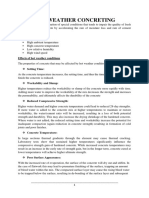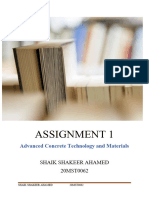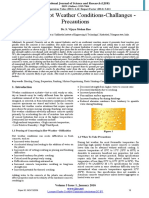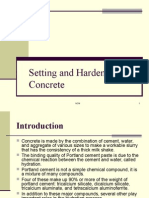0%(1)0% found this document useful (1 vote)
34 views12 - Hot Weather Concreting
12 - Hot Weather Concreting
Uploaded by
Hakan KuruoğluHot weather concreting requires special precautions to ensure proper handling, placing, finishing, and curing of concrete when temperatures are high. High temperatures can cause increased water demand, accelerated setting time, and early plastic shrinkage cracking in concrete. To account for these effects, modifications should be made to concrete mix designs, including using retarders, lower heat cement, and pozzolanic materials. Placement and finishing crews need to work quickly to place, finish, and cure concrete. Protecting fresh concrete from evaporation through fogging, windbreaks, and curing is important for successful hot weather concreting.
Copyright:
© All Rights Reserved
Available Formats
Download as PDF, TXT or read online from Scribd
12 - Hot Weather Concreting
12 - Hot Weather Concreting
Uploaded by
Hakan Kuruoğlu0%(1)0% found this document useful (1 vote)
34 views2 pagesHot weather concreting requires special precautions to ensure proper handling, placing, finishing, and curing of concrete when temperatures are high. High temperatures can cause increased water demand, accelerated setting time, and early plastic shrinkage cracking in concrete. To account for these effects, modifications should be made to concrete mix designs, including using retarders, lower heat cement, and pozzolanic materials. Placement and finishing crews need to work quickly to place, finish, and cure concrete. Protecting fresh concrete from evaporation through fogging, windbreaks, and curing is important for successful hot weather concreting.
Original Description:
Hot Weather Concreting
Copyright
© © All Rights Reserved
Available Formats
PDF, TXT or read online from Scribd
Share this document
Did you find this document useful?
Is this content inappropriate?
Hot weather concreting requires special precautions to ensure proper handling, placing, finishing, and curing of concrete when temperatures are high. High temperatures can cause increased water demand, accelerated setting time, and early plastic shrinkage cracking in concrete. To account for these effects, modifications should be made to concrete mix designs, including using retarders, lower heat cement, and pozzolanic materials. Placement and finishing crews need to work quickly to place, finish, and cure concrete. Protecting fresh concrete from evaporation through fogging, windbreaks, and curing is important for successful hot weather concreting.
Copyright:
© All Rights Reserved
Available Formats
Download as PDF, TXT or read online from Scribd
Download as pdf or txt
0%(1)0% found this document useful (1 vote)
34 views2 pages12 - Hot Weather Concreting
12 - Hot Weather Concreting
Uploaded by
Hakan KuruoğluHot weather concreting requires special precautions to ensure proper handling, placing, finishing, and curing of concrete when temperatures are high. High temperatures can cause increased water demand, accelerated setting time, and early plastic shrinkage cracking in concrete. To account for these effects, modifications should be made to concrete mix designs, including using retarders, lower heat cement, and pozzolanic materials. Placement and finishing crews need to work quickly to place, finish, and cure concrete. Protecting fresh concrete from evaporation through fogging, windbreaks, and curing is important for successful hot weather concreting.
Copyright:
© All Rights Reserved
Available Formats
Download as PDF, TXT or read online from Scribd
Download as pdf or txt
You are on page 1of 2
CIP 12 - Hot Weather Concreting
WHY Consider Hot Weather?
It is important that hot weather be taken into account
when planning concrete projects because of the potential effects on fresh and recently placed concrete.
High temperatures alone cause increased water demand, which, in turn, will raise the water-cement ratio
and result in lower potential strength. Higher temperatures tend to accelerate slump loss and can cause loss
of entrained air. Temperature also has a major effect
on the setting time of concrete: concrete placed under
high temperatures will set quicker and can, therefore,
require more rapid finishing. Concrete that is cured at
high temperatures at an early age will not be as strong
at 28 days as the same concrete cured at temperatures in the range of 70F (20C).
High temperatures, high wind velocity, and low relative humidity can affect fresh concrete in two important ways: the high rate of evaporation may induce
early plastic shrinkage or drying shrinkage cracking,
and the evaporation rate can remove surface water
300
Water content, lb/cu.yd.
Hot weather may be defined as any period of high
temperature in which special precautions need to be
taken to ensure proper handling, placing, finishing and
curing of concrete. Hot weather problems are most
frequently encountered in the summer, but the associated climatic factors of high winds, low relative humidity and solar radiation can occur at any time, especially in arid or tropical climates. Hot weather conditions can produce a rapid rate of evaporation of
moisture from the surface of the concrete and accelerated setting time, among other problems. Generally,
high relative humidity tends to reduce the effects of
high temperature.
310
290
280
270
3-in (75-mm) slump
1 1/2-in. (38-mm) aggregate
260
250
30
50
70
90
Concrete Temperature, F
110
Effect of temperature on water requirement of concrete (Ref. 1)
14
12
10
Initial Set, hr.
WHAT is Hot Weather?
8
6
4
2
0
40
60
80
100
Concrete Temperature, F
120
Effect of temperature on concrete setting time (Ref. 1)
necessary for hydration unless proper curing methods
are employed. Thermal cracking may result from rapid
drops in the temperature of the concrete, such as when
concrete stabs or walls are placed on a hot day followed by a cool night. High temperature also accelerates cement hydration and contributes to the potential
for thermal cracking in massive concrete structures.
HOW to Concrete in Hot Weather?
The key to successful hot weather concreting is:
1. recognition of the factors that affect concrete; and
2. planning to minimize their effects.
Use proven local recommendations for adjusting concrete proportions, such as the use of water reducing
and set retarding admixtures. Modifying the mixture
to reduce the heat generated by cement hydration,
such as the use of an ASTM Type II moderate heat
cement and the use of pozzolans and slag can reduce
potential problems with high concrete temperature. Advance timing and scheduling to avoid delays in delivery, placing and finishing is essential. Trucks should
be able to discharge immediately and adequate personnel should be available to place and handle the
concrete. When possible, deliveries should be scheduled to avoid the hottest part of the day. Limits on
maximum concrete temperature may be waived by
the purchaser if the concrete consistency is adequate
for the placement and excessive water addition is not
required.
In the case of extreme temperature conditions or with
mass concrete, the concrete temperature can be lowered by using chilled water or ice as part of the mixing
water. The ready mixed concrete producer uses other
measures, such as sprinkling and shading the aggre-
gate prior to mixing, to help lower the temperature of
the concrete.
If low humidity and high winds are predicted, windbreaks, sunscreens, mist fogging, or evaporation retardants may be needed to avoid plastic shrinkage
cracking in slabs.
References
1. Hot Weather Concreting, ACI 305R, American Concrete
Institute, Farmington Hills, MI.
2. Cooling Ready Mixed Concrete, NRMCA Publication
No. 106, NRMCA, Silver Spring, MD.
3. Effect of Temperature and Delivery Time on Concrete
Proportions, R.D. Gaynor, R.C. Meininger, T.S. Khan,
NRMCA Publication 171, NRMCA, Silver Spring, MD.
4. Hot-Weather Concreting, Chapter 11 in Design and Control of Concrete Mixtures, Portland Cement Association,
Skokie, IL.
5. Keeping Concrete Cool in the Heat of Summer, K.C.
Hover, Concrete Construction, June 1993.
Follow These Rules for Hot Weather Concrete
1. Modify concrete mix designs as appropriate. Retarders, moderate heat of hydration cement, pozzolanic
materials, slag, or other proven local solutions may be used. Reduce the cement content of the mixture
as much as possible, while ensuring the concrete strength will be attained.
2. Have adequate manpower to quickly place, finish and cure the concrete.
3. Limit the addition of water at the job siteadd water only on arrival at the job site to adjust the slump.
Water addition should not exceed about 2 to 21/2 gallons per cubic yard (10 to 12 L/m3). Adding water to
concrete that is more than 11/2 hours old should be avoided.
4. Slabs on grade should not be placed directly on polyethylene sheeting or other vapor retarders. Cover the
vapor retarder with a minimum 4-inch (100 mm) layer of compactible, easy-to-trim, granular fill material.
5. On dry and/or hot days, when conditions are conducive for plastic shrinkage cracking, dampen the
subgrade, forms and reinforcement prior to placing concrete, but do not allow excessive water to pond.
6. Begin final finishing operations as soon as the water sheen has left the surface; start curing as soon as
finishing is completed. Continue curing for at least 3 days; cover the concrete with wet burlap and plastic
sheeting to prevent evaporation or use a liquid membrane curing compound, or cure slabs with water (See
CIP 11). Using white pigmented membrane curing compounds will help by indicating proper coverage and
reflecting heat away from the concrete surface.
7. Protect test cylinders at the jobsite by shading and preventing evaporation. Field curing boxes with ice or
refrigeration may be used to ensure maintaining the required 60 to 80F (17 to 27C) for initial curing of
cylinders. (See CIP 9)
8. Do not use accelerators unless it is common practice to avoid plastic shrinkage cracking and expedite
finishing operations.
1982, 1989 AND 2000
You might also like
- Mold Polishing Tips and GuidelinesDocument2 pagesMold Polishing Tips and GuidelinesNazri0% (1)
- Housing TechnologiesDocument9 pagesHousing TechnologiesKawaii CraftsNo ratings yet
- CIP 12 - Hot Weather ConcretingDocument2 pagesCIP 12 - Hot Weather ConcretingSatt PaingNo ratings yet
- Hot Weather Concreting 1696843662Document3 pagesHot Weather Concreting 1696843662ashiq.arNo ratings yet
- Hot and Cold Weather ConcretingDocument7 pagesHot and Cold Weather ConcretingFaisal Gulzar100% (1)
- 12pr PDFDocument2 pages12pr PDFAlban TabakuNo ratings yet
- CIP 12 Hot Weather ConcretingDocument2 pagesCIP 12 Hot Weather ConcretingTim_CNo ratings yet
- Cold Weather ConcretingDocument2 pagesCold Weather ConcretingBoris DikovNo ratings yet
- Hot Weather Concreting-1Document37 pagesHot Weather Concreting-1ephNo ratings yet
- Hot Weather ConcretingDocument31 pagesHot Weather ConcretingLalitha Krishna MoorthyNo ratings yet
- Hot - Weather Creaton 2Document7 pagesHot - Weather Creaton 2Pankaj PriyadarshiNo ratings yet
- Hot Weather ConcretingDocument6 pagesHot Weather Concretingharish420No ratings yet
- Hot Weather ConcretingDocument74 pagesHot Weather ConcretingTonyBuiNo ratings yet
- Hotcon PDFDocument7 pagesHotcon PDFjack21abNo ratings yet
- Hot Weather ConcretingDocument26 pagesHot Weather ConcretingSaulat JillaniNo ratings yet
- 07-November-2014-Cpni Concrete Curing Guidance Note PDFDocument3 pages07-November-2014-Cpni Concrete Curing Guidance Note PDFRADADNo ratings yet
- CIP Cold WeatherDocument2 pagesCIP Cold WeatherGrou RiakNo ratings yet
- 6 Hot Weather Concreting ACI 305Document61 pages6 Hot Weather Concreting ACI 305Hashiru JīpuNo ratings yet
- Curing - MainDocument1 pageCuring - MainGirma JankaNo ratings yet
- Impact of Weather Conditions On ConcretingDocument3 pagesImpact of Weather Conditions On ConcretingTahmidtuhinNo ratings yet
- Hot Weather ConcretingDocument6 pagesHot Weather ConcretingMazharYasinNo ratings yet
- Assignment 1 (Acmt)Document14 pagesAssignment 1 (Acmt)Jeevan kumar GounipalliNo ratings yet
- CIP05-Plastic Shrinkage CrackingDocument2 pagesCIP05-Plastic Shrinkage Cracking7774R105No ratings yet
- Concrete in Hot Weather Conditions-Challanges - Precautions: Dr. S. Vijaya Mohan RaoDocument6 pagesConcrete in Hot Weather Conditions-Challanges - Precautions: Dr. S. Vijaya Mohan RaoHussain ElarabiNo ratings yet
- Hot Weather ConcretingDocument10 pagesHot Weather ConcretingAgramovic PetarNo ratings yet
- Setting Time of ConcreteDocument1 pageSetting Time of ConcretemiyaeunchaeNo ratings yet
- FA18-CVE-001 - Poc p-001Document9 pagesFA18-CVE-001 - Poc p-001ALI RAZANo ratings yet
- Special Concrete (2)Document15 pagesSpecial Concrete (2)govtpolytechnicudhampurNo ratings yet
- Irc 061-1976Document13 pagesIrc 061-1976harivennelaNo ratings yet
- Extreme Weather Concreting and Chemical Admixtures in ConcreteDocument8 pagesExtreme Weather Concreting and Chemical Admixtures in ConcretetyashraniNo ratings yet
- Conc - Tech Lec-5Document17 pagesConc - Tech Lec-5kassawNo ratings yet
- Cold Weather Concrete TipsDocument2 pagesCold Weather Concrete TipsArmenak BaghdasaryanNo ratings yet
- Issue 01 Hot Weather Concreting R2Document6 pagesIssue 01 Hot Weather Concreting R2Jayaprakash SrinivasanNo ratings yet
- Temperature - 1Document2 pagesTemperature - 1ksshashidharNo ratings yet
- Special Concreting TechnequesDocument26 pagesSpecial Concreting TechnequesParth AnajwalaNo ratings yet
- Thermal Cracking of ConcreteDocument2 pagesThermal Cracking of ConcreteChatchai ManathamsombatNo ratings yet
- CE 308 Lec 13 Special Weather ConcretingDocument12 pagesCE 308 Lec 13 Special Weather ConcretingwasimkhaliqNo ratings yet
- Emerging Lecture 2 & 3Document48 pagesEmerging Lecture 2 & 3izim izimNo ratings yet
- Hot Weather ConcretingDocument21 pagesHot Weather ConcretingDr Yousif HummaidaNo ratings yet
- Hot and Cold W. ConcreteDocument15 pagesHot and Cold W. ConcreteAyaz KhanNo ratings yet
- Cold Weather ConcretingDocument52 pagesCold Weather ConcretingSukhwinder Singh GillNo ratings yet
- CIP 11 - Curing In-Place ConcreteDocument0 pagesCIP 11 - Curing In-Place ConcreteCarol MBNo ratings yet
- Setting and Hardening of ConcreteDocument30 pagesSetting and Hardening of ConcreteManjer123No ratings yet
- Chapter 4 Hot and Cold Weather ConcreteDocument30 pagesChapter 4 Hot and Cold Weather Concretewasse5515No ratings yet
- WHAT Is Plastic Shrinkage CrackingDocument2 pagesWHAT Is Plastic Shrinkage CrackingMikel MenesesNo ratings yet
- 10.hot Weather ConcretingDocument3 pages10.hot Weather ConcretingamanbabuhereNo ratings yet
- CIP 5 Plastic Shrinkage Cracking PDFDocument2 pagesCIP 5 Plastic Shrinkage Cracking PDFSwëêt Rãsçäl SëlvåNo ratings yet
- Temperature and Effect On ConcreteDocument59 pagesTemperature and Effect On ConcreteBart KwanNo ratings yet
- CuringDocument2 pagesCuringJinsoo ChungNo ratings yet
- Self Curing ConcreteDocument26 pagesSelf Curing Concretepraveenpv7No ratings yet
- Concreting in Extreme Weather ConditionsDocument43 pagesConcreting in Extreme Weather Conditionsmansoor azam100% (1)
- 1 Mass ConcreteDocument38 pages1 Mass ConcreteJayel GuintoNo ratings yet
- MASS CONCRETE METHOD STATEMENT - FinalDocument89 pagesMASS CONCRETE METHOD STATEMENT - FinalMichael Assefa100% (1)
- Concrete Temperature Controlling During Mix DesignDocument4 pagesConcrete Temperature Controlling During Mix DesignabguyNo ratings yet
- Sustainable Renovation: Strategies for Commercial Building Systems and EnvelopeFrom EverandSustainable Renovation: Strategies for Commercial Building Systems and EnvelopeNo ratings yet
- How to Build Shipping Container Homes With PlansFrom EverandHow to Build Shipping Container Homes With PlansRating: 3 out of 5 stars3/5 (5)
- 77th Conference on Glass Problems: A Collection of Papers Presented at the 77th Conference on Glass Problems, Greater Columbus Convention Center, Columbus, OH, November 7-9, 2016From Everand77th Conference on Glass Problems: A Collection of Papers Presented at the 77th Conference on Glass Problems, Greater Columbus Convention Center, Columbus, OH, November 7-9, 2016S. K. SundaramNo ratings yet
- The Modern Bricklayer - A Practical Work on Bricklaying in all its Branches - Volume III: With Special Selections on Tiling and Slating, Specifications Estimating, EtcFrom EverandThe Modern Bricklayer - A Practical Work on Bricklaying in all its Branches - Volume III: With Special Selections on Tiling and Slating, Specifications Estimating, EtcRating: 5 out of 5 stars5/5 (1)
- PDF e TNF Swellseal 8vDocument4 pagesPDF e TNF Swellseal 8vHakan KuruoğluNo ratings yet
- PDF e TNF Swellseal RDocument2 pagesPDF e TNF Swellseal RHakan KuruoğluNo ratings yet
- Installation Instructions: ISO 9001 ISO 9001Document2 pagesInstallation Instructions: ISO 9001 ISO 9001Hakan KuruoğluNo ratings yet
- Sikaflex® 221: Safety Data SheetDocument12 pagesSikaflex® 221: Safety Data SheetHakan KuruoğluNo ratings yet
- Antisol - 15 PDFDocument3 pagesAntisol - 15 PDFHakan KuruoğluNo ratings yet
- RCC Mix Taum SaukDocument15 pagesRCC Mix Taum Saukwey5316100% (1)
- Installation Instructions: ISO 9001 ISO 9001Document2 pagesInstallation Instructions: ISO 9001 ISO 9001Hakan KuruoğluNo ratings yet
- CompexDocument2 pagesCompexHakan Kuruoğlu33% (3)
- Antisol - 15Document3 pagesAntisol - 15Hakan KuruoğluNo ratings yet
- Ball Valve BrochureDocument32 pagesBall Valve BrochureHakan KuruoğluNo ratings yet
- The Caspian Sea ChessboardDocument240 pagesThe Caspian Sea ChessboardHakan KuruoğluNo ratings yet
- Packing Related Standards, Regulations and GuidelinesDocument3 pagesPacking Related Standards, Regulations and GuidelineswholenumberNo ratings yet
- Fire Stopping GuideDocument6 pagesFire Stopping GuidestephlyonNo ratings yet
- Pipelines Process PipingDocument16 pagesPipelines Process PipingmariomatoNo ratings yet
- WHITFORD CatalogueDocument6 pagesWHITFORD CatalogueNisa_nisheNo ratings yet
- Quantity Surveying Class ExercisesDocument32 pagesQuantity Surveying Class Exercisesharsha vardhan75% (4)
- Manhour StandardsDocument6 pagesManhour StandardsErick EnriquezNo ratings yet
- APPENDIX 1: Recommended Roughness ValuesDocument2 pagesAPPENDIX 1: Recommended Roughness ValuesalvinchuanNo ratings yet
- Spinning Objective QuestionsDocument5 pagesSpinning Objective QuestionsBhuva_jana91% (11)
- Optimization of Bag FiltersDocument8 pagesOptimization of Bag FiltersAnand Gupta100% (1)
- Gulf Precast BrochureDocument13 pagesGulf Precast BrochureMohammad Abu-RadiNo ratings yet
- HDPE - Specification and DetailsDocument1 pageHDPE - Specification and DetailsvkmsNo ratings yet
- Termapaper-Design and ManufacturingDocument12 pagesTermapaper-Design and ManufacturingOmkar Kumar JhaNo ratings yet
- Coal Miners SuitDocument4 pagesCoal Miners SuitSudipta BainNo ratings yet
- Carboguard 60 PDSDocument2 pagesCarboguard 60 PDSsalamrefigh0% (1)
- Concrete Panel House GuideDocument44 pagesConcrete Panel House GuideJustin CorbettNo ratings yet
- Final BMC Glass FlooringDocument20 pagesFinal BMC Glass FlooringARAV PRAJAPATINo ratings yet
- Inconel - Alloy 050 - UNS N06950Document2 pagesInconel - Alloy 050 - UNS N06950Javeed A. KhanNo ratings yet
- Bentone 38 - TDS - eDocument2 pagesBentone 38 - TDS - eDũng ĐỗNo ratings yet
- Abrasive Material Removal Processes: Chapter # 4Document42 pagesAbrasive Material Removal Processes: Chapter # 4Jeff HardyNo ratings yet
- Stainless Steel Chloride Corrosion PDFDocument8 pagesStainless Steel Chloride Corrosion PDFSaut Maruli Tua SamosirNo ratings yet
- Hanger CatalogueDocument4 pagesHanger CatalogueDnyaneshwar100% (1)
- Plaster - Wikipedia, The Free EncyclopediaDocument7 pagesPlaster - Wikipedia, The Free EncyclopediaBaguma Grace GariyoNo ratings yet
- Fibres Yarns and FabricDocument4 pagesFibres Yarns and Fabricapi-281768577No ratings yet
- No Tejido 1Document24 pagesNo Tejido 1WILLYCALSINANo ratings yet
- Bonded Joints PresentationDocument19 pagesBonded Joints Presentationmartin_calmonNo ratings yet
- PlasticizerDocument7 pagesPlasticizerNick NormNo ratings yet
- Toilet Paper Factors of ProductionDocument6 pagesToilet Paper Factors of ProductionLayneGelleiMeneses-MillaminaBuenaventeNo ratings yet
- Floor FinishesDocument23 pagesFloor FinishesHafizah Ezani100% (1)




































































































